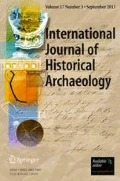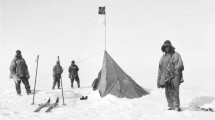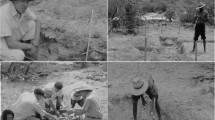Abstract
Antarctica was the last continent to be discovered in the early nineteenth century. In order to become acquainted with the process of incorporation of Antarctica to the scope of the capitalist system we have focused on particularity: i.e., specific economic and technological and ideological aspects of everyday life in sealer camps spread along the coastline of the South Shetland Islands. Archaeological research in Byers Peninsula–Livingston Island provides an approach to the mechanisms implemented to organize the first resource exploitation in these lands.
Similar content being viewed by others
References
Anon, J. (1983). The restoration of Mawson’s hut. Aurora 9: 3–22.
Arrastía de Viglione, H., Belfiore de Carrara, M., and Capdevilla, R. (1987). Síntesis bibliográfica de aportes sobre el pasado antártico realizados en congresos nacionales de historia. Contribuciones del Instituto Antártico Argentino 343. Dirección Nacional del Antartico, Instituto Antartico, Argentino, Buenos Aires.
Berguño, J. (1993a). Las Shetland del Sur: el ciclo lobero. Primera parte. Boletín Antártico Chileno Abril: 5–13.
Berguño, J. (1993b). Las Shetland del Sur: el ciclo lobero. Segunda parte. Boletín Antártico Chileno Octubre: 2–9.
Bertrand, K. (1971). Americans in the Antarctica 1775–1948. American Geographical Society Special Publication 39, American Geographical Society, New York.
Cabrera, L. (2002). Arqueología Histórica en el continente Antártico; Tras el fantasma del San Telmo. Paper presented at Actas del I Congreso de Arqueología Historica. Corregidor, Buenos Aires.
Capdevilla, R. (1992). Arqueología Histórica en la Antártida. Contribuciones del Instituto Antartico 411. Dirección Nacional del Antartico, Instituto Antartico, Argentino, Buenos Aires.
Capdevilla, R., and Agritos, J. (1993). Restauración de la Choza Sueca de Bahía Esperanza. Contribuciones del Instituto Antartico 417, Dirección Nacional del Antartico, Instituto Antartico, Argentino, Buenos Aires.
Chester, J. (1986). Going to Extremes: Project Blizzard and Australia’s Antarctic Heritage, Doubleday, Sydney.
Comerci, S. (1983). Arqueológia antártica: Los Trabajos de la República Argentina en la Isla Cerro Nevado durante las Campañas de 1979–80 y 1980–81. Contribuciones del IAA 291, Dirección Nacional del Antártico, Instituto Antártico Argentino, Buenos Aires.
Cooper, J., and Avery, R. (eds.). (1986). Historical Sites at the Prince Edward Islands. South Africa National Science Report 128. Council for Scientific and Industrial Research, Pretoria, South Africa.
Donzelot, J. (1981). Espacio cerrado, trabajo y moralización. In Foucault, M., Donzelot, J., Grignon, C., Gaudemar, J., Muel, F., and Castel, R. (eds.), Espacios de Poder, La Piqueta, Madrid, pp. 85–114.
Fitte, E. (1959). Una aventura de náufragos en las Islas Malvinas. Boletín del Instituto Bonaerense de Numismática y Antigüedades 7: 47–67.
Fitte, E. (1962). El Descubrimiento de la Antártida, Crónica de los hombres y barcos que exploraron las aguas de las Shetland del Sur, EMECE, Buenos Aires.
Fitte, E. (1974). Crónicas del Atlántico Sur: Patagonia, Malvinas y antártica, EMECE, Buenos Aires.
Forrester, V. (1996). El horror económico, Fondo de Cultura Económica, México.
Foucault, M. (1976). Vigilar y Castigar. El Nacimiento de la Prisión, Siglo XXI, Mexico.
Foucault, M. (1981). Un diálogo sobre el poder, Alianza, Madrid.
Foucault, M. (1986). Microfísica del poder, Alianza, Madrid.
Funari, P., Jones, S., and Hall, M. (1999). Introduction: Archaeology in history. In Funari, P., Jones, S., and Hall, M. (eds.), Back From the Edge: Historical Archaeology from a World Perspective, Routledge, London, pp.1–20.
Gaudemar, J. (1981). Para una genealogía de las formas de la disciplina en el proceso capitalista de trabajo. In Foucault, M., Donzelot, J., Grignon, C., Gaudemar, J., Muel, F., and Castel, R. (eds.), Espacios de Poder, La Piqueta, Madrid, pp. 115–138.
Harrowfield, D. (1978). Historical archaeology in Antartica. New Zealand Antarctic Record 1(3): 45–50.
Hobbs, G. (1968). The geology of Livingston Island. The geology of the South Shetlands. British Antarctic Survey Scientific Report 34, British Antarctic Survey, London.
Hodge, J. (1976). El Extremo Sur de América. América 28(8): 7–16.
Hopkins, T., and Wallerstein, I. (1987). Concluding note. Review 10(5/6 Suppl.): 901–902.
Johnson, M. (1999) Historical, archaeology, capitalism. In Leone, M., and Potter, P. (eds.), Historical Archaeologies of Capitalism: Contributions to Global Historical Archaeology, Kluwer, New York, pp. 219–232.
Lucero, V., and Stehberg, R. (1996). Arqueología Histórica Antártica: relevamiento y excavación de sitios de cazadores de lobos del siglo pasado. Islas Shetland del Sur. Historical Archaeology in Latin America 14: 99–106.
Martín-Bueno, M. (1995a). Proyecto de San Telmo. Informe sobre las actividades científicas de España en Antártida durante la campaña 1993–94, pp. 249–265. Comisión Interministerial de Ciencia y Tecnología, Madrid.
Martín-Bueno, M. (1995b). Arqueología Antártica: el Proyecto San Telmo y el descubrimiento de la Terra Australis Antártica. Actas del V Simposio de Estudios Antárticos 5: 421–428.
Martín-Bueno, M. (1996). Proyecto de San Telmo: Arqueología terrestre y subacuática en Isla Livingston e Isal Desolación (Antártida). Informe sobre las actividades científicas de España en Antártida durante la camppaña 1994–95, pp. 173–179. Comisión Interministerial de Ciencia y Tecnología, Madrid.
Martin, L. (1940). Antarctica discovered by a Connecticut yankee, Captain Nathaniel Brown Palmer. The Geographical Review 30(4): 529–562.
Marx, K. (1959) El capital, Fondo de Cultura Económica, México.
McGowan, A. (2000). On their own: towards an analysis of sealers’ sites on Heard Island, Heard Islands Papers. Papers of the Proceedings of the Royal Society of Tasmania 133(2): 61–70.
Miers, J. (1920). Account of the discovery of New South Shetland, with observations on its importance in geographical, commercial and political point of view: With two plates. Edinburgh Philosophical Review 3: 367–380.
Moreno, P. (2000). Botellas de vidrio en la Península Byers, Isla Livingston, Shetland del Sur. Actas del IV Congreso Argentino de Americanistas 4: 207–228.
Muñoz, S. (1997). El registro arqueofaunístico de la Península Byers, Isla Livingston, Shetland del Sur. Actas del V Simposio de Estudios Antárticos 5: 11–14.
Muñoz, S. (2000). Zooarqueología de la Península Byers, I. Livingston Shetland del Sur. Zooarqueologica 9: 39–57.
New Zealand Antarctic Society (1977a). Damage to Relics at Historic Huts. Antarctic 8(2): 47–49.
New Zealand Antarctic Society (1977b). Work on Historic Huts. Antarctic 8(3): 80.
New Zealand Antarctic Society (1978a). Caretakers for Historic Huts. Antarctic 8(5):146.
New Zealand Antarctic Society (1978b). Inventory of Relics in Historic Huts. Antarctic 8(6): 197–201.
New Zealand Antarctic Society (1995a). The Northernmost Hut. Antarctic 13(9): 389–393.
New Zealand Antarctic Society (1995b). Six New Historic Sites named in Ross Dependency. Antarctic 13(10): 405–410.
O’Gorman, F. (1963). The return to the Antarctic fur seal. New Scientist 20: 6–374.
Orser, C., Jr. (1996). A Historical Archaeology of the Modern World, Plenum, New York.
Ossoinak Garibaldi, E. (1950). Cronología de los Viajes a las Regiones Australes. Antecedentes Argentinos. Publicación 12, Universidad de Buenos Aires, Instituto de la Producción, Buenos Aires.
Pinochet de la Barra, O. (1992). El misterio del San Telmo ?‘Náufragos españoles pisaron por primera vez la Antártida? Boletín Antártico Chileno Abril: 2–5.
Quartermain, L. (1963). Two Huts in the Antarctic, R.E. Owen, Wellington.
Richards, R. (1982). The commercial exploitation of sea mammals at Iles Crozet and Prince Edwards Islands before 1850. Polar Monographs 1.
Rosh, R. (1989). Antarctica’s increasing incorporation into the world-system. Review 7(1): 12–17.
Senatore, M. X. (1999) Reflexiones sobre los Europeos en Patagonia. In Desde el país de los gigantes. Perspectivas Arqueológicas en Patagonia, Vol. 1, Universidad Nacional de la Patagonia Austral, Río Gallegos, Río Gallegos. pp. 269–281.
Senatore, M. X., and Zarankin, A. (1996). Arqueología Histórica en Antártica, Research Report presented to Instituto Antártico Argentino. On file at Instituto Antártico Argentino, Buenos Aires.
Senatore, M. X., and Zarankin, A. (1997). Arqueología Histórica en Antártida. Avances en la Investigación. Actas del II Congreso Argentino de Americanistas 2: 585–603.
Senatore, M. X., and Zarankin, A. (1999). Arqueología Histórica y expansión capitalista. Prácticas cotidianas y grupos operarios en la Península Byers, Isla Livingston, Shetland del Sur. In Zarankin, A., and Acuto, F. (eds.) Sed Non Satiata; Teoría Social en la Arqueología Latinoamericana Contemporánea, Del Tridente, Buenos Aires, pp.171–188.
Silva, H. (1985). La pesca y caza de lobos y anfibios. La Real Companía Marítima de pesca en Deseado (1790–1807). In Historia Marítima Argentina, Vol. 4, Departamento de Estudios Históricos Navales, Armada de la República Argentina, Buenos Aires, pp. 507–529.
Slaney, H. (1921). Notice of the voyage of Edward Barnsfield, Master of his Majestyás Ship Andromache, to New South Shetland. Edinburgh Philosophical Journal 4: 345–348.
Smith, L. R., and Simpson, H. (1987). Early nineteenth century sealersárefuges on Livingston Island, South Shetland Islands. British Antarctic Survey Bulletin 74: 49–72.
Stackpole, E. (1955). The Voyages of the Huron and the Huntress: The American Sealers and the Discovery of the Continent of Antarctica, Marine Historical Association, Mystic, CT.
Stehberg, R., and Lucero, V. (1985a). Contexto arqueológico del hallazgo de restos humanos en Cabo Shirref, Isla Livingston. Serie Cientifica del Instituto Antartico Chileno 45: 59–66.
Stehberg, R., and Lucero, V. (1985b). Arqueología Histórica de la Isla Desolación. Evidencias de coexistencia entre cazadores de lobo de origen europeo y aborígenes del extremo sur americano, en la segunda decada del siglo pasado. Serie Científica del Instituto Antártico Chileno 45: 67–88.
Stehberg, R., and Nilo, L. (1983). Procedencia Antártica de dos Puntas de Proyectil. Boletin Antartico Chileno 3(1): 2–21.
Stehberg, R., and Cabeza, A. (1987). Comienzos de la Arqueología Histórica Antártica en el Sitio Cuatro Pircas. Revista Chilena de Antropología 6: 83–111.
Torres, D. (1992). Cráneo indígena en cabo Shirreff?: un estudio en desarrollo. Boletín Antártico Chileno Octubre, pp. 2–6.
Wallerstein, I. (1974). The Modern World-System: Capitalism Agriculture and the Origins of the European World-Economy in the Sixteenth Century, Academic Press, New York.
Zarankin, A., and Senatore, M. X. (1996). Ocupación Humana en Tierras Antárticas: una aproximación arqueológica. Soplando el viento. Actas de las Terceras Jornadas de Arqueología de la Patagonia 3: 629–644.
Zarankin, A., and Senatore, M. X. (1997). Arqueología en Antártida. Primeras Estrategias Humanas de Ocupación y Explotación en Península Byers, Isla Livingston, Shetland del Sur. Actas de las Cuartas Jornadas de Investigaciones Antárticas. Instituto Antártico Argentino 4: 7–10.
Zarankin, A., and Senatore, M. X. (1999a). Hasta el fin del Mundo: Arqueología Antártica. Praehistoria 3: 219–236.
Zarankin, A., and Senatore, M. X. (1999b) Arqueología en Antártida, Estrategias, Tácticas y los paisajes del capitalismo. In Desde el país de los gigantes. Perspectivas Arqueológicas en Patagonia. Vol. 1, Universidad Nacional de la Patagonia Austral, Río Gallegos, Río Gallegos, pp. 315–327.
Author information
Authors and Affiliations
Corresponding author
Rights and permissions
About this article
Cite this article
Zarankin, A., Senatore, M.X. Archaeology in Antarctica: Nineteenth-Century Capitalism Expansion Strategies. Int J Histor Archaeol 9, 43–56 (2005). https://doi.org/10.1007/s10761-005-5672-y
Issue Date:
DOI: https://doi.org/10.1007/s10761-005-5672-y




